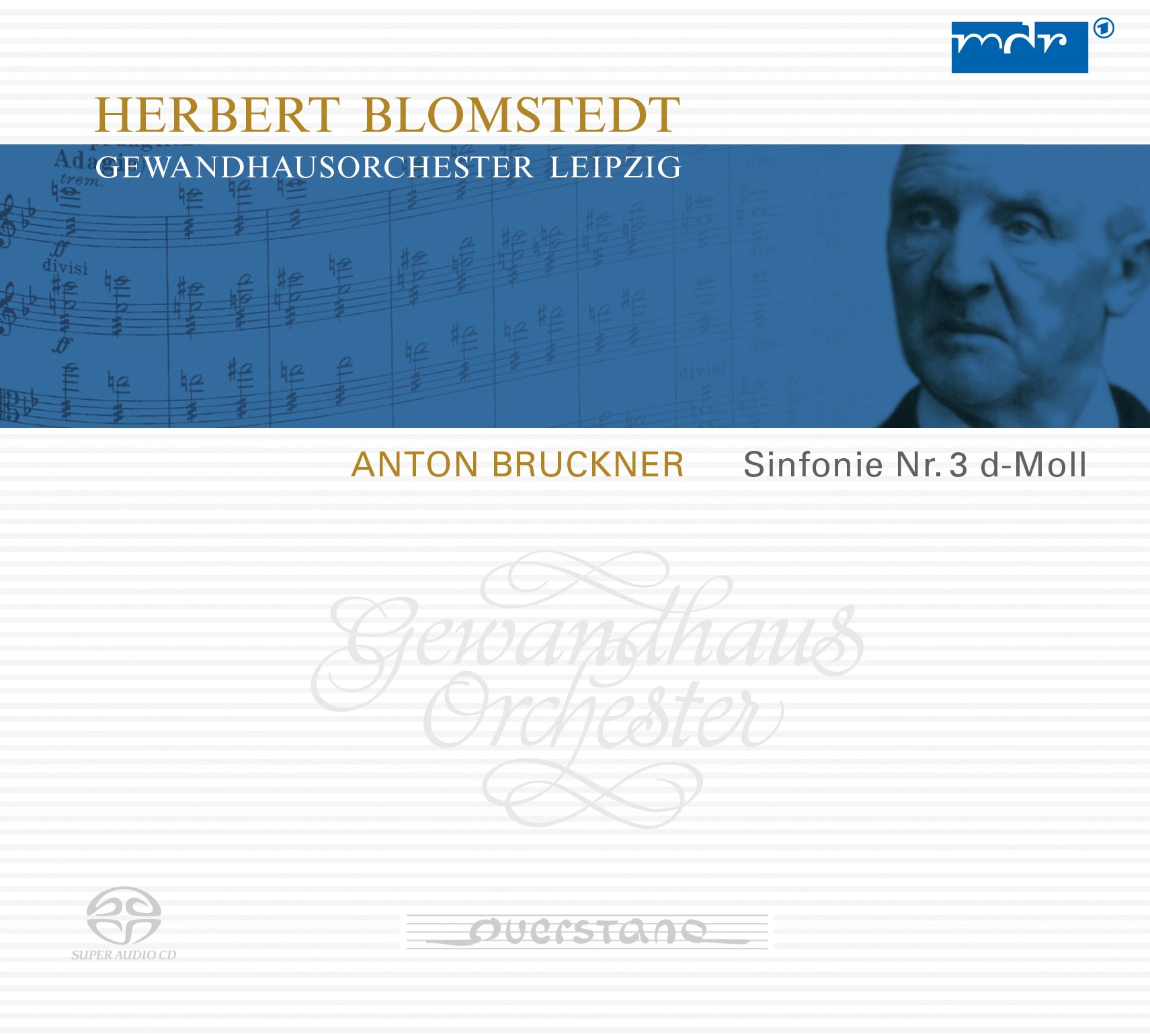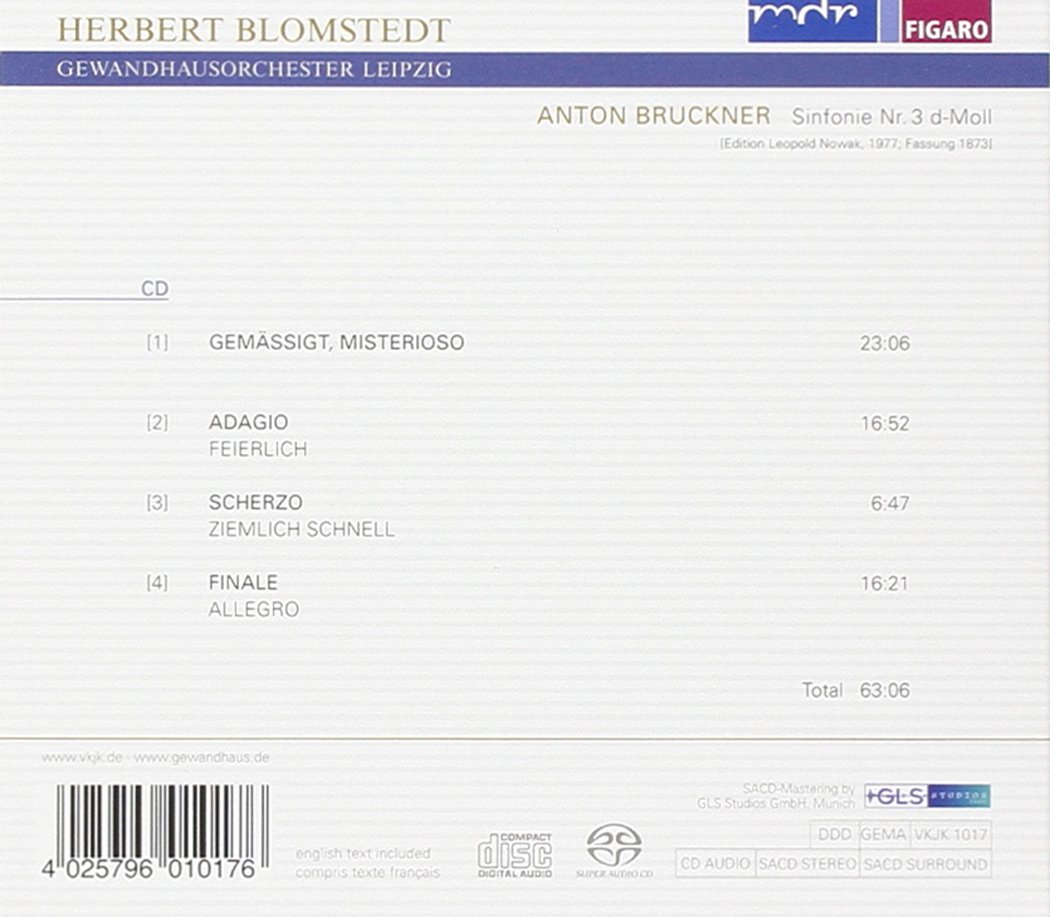Customer Services
Copyright © 2025 Desertcart Holdings Limited
Desert Online General Trading LLC
Dubai, United Arab Emirates



SACD/CD hybrid issue of a live recording made on 23rd and 24th September 2010 in the Gewandhaus, Leipzig. This is a further issue in the series of Bruckner Symphonies recorded live by these artists. Previous issues feature Symphonies 5, 6, 7 & 8.
S**E
Glorious recording and music making reveal that Bruckner got it right first time. A MUST for Brucknerians!
Let's deal with the technical stuff first-this live 2010 performance is in state-of-the art sound in both stereo and SACD. There is a beautiful, warm organic sound, perfectly detailed and with a very wide dynamic range-not much compression if any. Contrasts between the extreme ppp and fff markings are brilliantly captured. This great orchestra plays with an assuredness and finesse that bring tears of joy to the lover of great music making. While this is very much a North German sound, eschewing the "dirty" string tone of Vienna and the riper Brass of Vienna and Munich, there is no lack of warmth about the sound, and the burnished and homogenous string tone surpasses in excellence that of Berlin and rivals that of Dresden, and is worthy of the highest possible praise.Herbert Blomstedt had already established his Bruckner credentials in the early 80's with 2 superb recordings-4&7-for Denon with the Dresden Staatskapelle both of which were "Critics Choice" versions for many years and which I still treasure. In this cycle of live recordings from performances in the New Leipzig Gewandhaus with its superb acustics, he has not adhered slavishly to one set of editions, so that he adopts the Haas for the Eighth and the 2000 Benjamin Cohrs ( the "C" of the SPCM committee) which purportedly corrects some errors in the Nowak Edition for the Ninth (which is superb!).The Third Symphony is a nightmare when it comes to "Editions"-Nowak gave up after 3 separate editions, there is a pre-war Haas, bowdlerised versions by Ferdinand Lowe, Schalk and various others not to mention the Marthé Reloaded version which I love for the sheer beauty, grandeur-and cheek of it.Blomstedt adopts the rare approach of " going back to basics"-he uses the infrequently played Nowak Edition of the 1877 Publication of the 1873 Original Score!-in layman's terms, this is the very first, uncorrected, full length version of the symphony with the quotes from and allusions to the music of Wagner fully intact, and none of the later deletions by Bruckner or anyone else applied!This is rare enough in itself (I will not countenance the Norrington HIP version!), but in such a wonderfully convincing performance, this version establishes itself as a neglected triumph.Blomstedt unfolds the work swiftly but with perfect shaping, and with the lighter scoring, this approach relates this work more to Schubert than I have ever heard, for it must be remembered that in this symphony, Schubert was as much an influence on Bruckner as was Wagner. The pauses, especially in the first movement, are all there and pronounced but not exaggerated, the second movement is majestic and moving, the Scherzo whips past with utmost brilliance in 6 minutes, and the finale is joyous and exultant-and does not outstay its welcome at this tempo. As I have mentioned the allusions to Wagner, particularly Walkure, Tristan and Tannhauser are obvious and in no way either inappropriate or in bad musical taste, and it is hard now to understand why Bruckner felt he had to excise them.This is a truly glorious achievement and the rapturous applause included at the end of the finale is more than justified. I would go so far as to say that it will change your view on this great work and its very nature-it certainly has mine. It is a triumph on every level, recording, playing, conducting-and in its composition. Even the slim album packaging is beautiful , with some of the most comprehensive and informative notes I have encountered. Those who prefer the more usually played 1889 version have a wide choice with Karajan providing a near perfect reading spoiled by rather edgy early digital sound, Haitink is convincing with the VPO especially, Celibidache gives us the monumental view, and Wand is reliable in all his versions. Those seeking a stunning recording of the 1889 version could do worse than the underrated Jansons recording with the RCO live and coupled with an equally fine recording of the 4th.A bargain alternative to the Blomstedt is the very fine Inbal/Frankfurt recording, also of the 1873 version and well played and conducted in bright early digital sound, but which lacks the tonal richness and weight of string tone of this recording. I am afraid that I am not an admirer of the unfortunate Georg Tintner's Bruckner and would not recommend the Naxos recording. This Blomstedt recording, however, clearly reveals that Bruckner got it right first time and is now my top recommendation!Unlimited Stars and unreservedly recommended . Stewart Crowe
L**S
Getting used to this fine performance
I have taken a little time to get used to this version, having been used to Skrowacewski and Jochum performances of different editions of the work. The performance is obviously very fine and the recording most impressive, even if occasionally the melody line gets a bit swamped in climaxes. This happens somewhat with the trumpets just before the rather abrupt ending of the work, but if you know it you can discern what is going on. Other than that the sound is a triumphant realisation of what an orchestra playing Bruckner can sound like and the performance is undoubtedly superb .
I**I
Blomstedt's Bruckner...
Excellent.
U**R
This is by far the best recording I know of the original version of Bruckner ...
This is by far the best recording I know of the original version of Bruckner 3. Superbly played, conducted, and recorded. Just get it!
D**M
Five Stars
My husband is very pleased with this present.
M**)
Excellent
A most satisfying, thoughtful interpretation, impressively played and recorded.
S**S
Best Bruckner 3
I only came to this because this was deemed to be the very best performance of Bruckner 3 by BBCBaL. Bruckner has overtaken Mahler in my affections for symphonies and having heard a bunch of different versions, this is the very best you'll find of 3. I kid you not.
D**Y
Special
In this performance of Bruckner's 3rd, recorded live in September 2010 in the Great Hall of the Gewandhaus, Blomstedt has opted for the first version of the score, completed in 1873 but never performed or published in the composer's lifetime. Bruckner went on to make significant revisions to the score, resulting in two further distinct versions: that of 1877 and that of 1889. The changes include the almost total removal of various quotations from Wagner operas (Brunnhilde's Magic Sleep motif from Die Walkure, for example, is removed from the end of the development of the first movement, although it is retained at the conclusion of the second movement), the significant truncation of the second and final movements (particularly as wrought by the 1889 version in relation to the final movement), and any number of alterations concerning instrumentation, rhythm etc. While a number of Bruckner scholars (eg Robert Simpson) have come to view these changes as doing more harm than good, the 1889 version remains the most popularly performed, although, based on current recording trends, the 1873 version is certainly growing in popularity.In this recording one is left in no doubt as to the conductor's passionate conviction in the 1873 version. The performance is characterised by an inexorable forward progress, culminating in a final movement that has an almost unbridled energy and excitement, qualities which seem entirely appropriate for this rather wild music but which many would not automatically associate with this conductor. Even in the second movement, Blomstedt adopts a flowing pace, the virtues of which are apparent, for example, when the opening theme emerges for the third time in the five-part structure (from 12'00). Here, with winds supported by bowing strings and soon joined by brass, Blomstedt and his players generate an enormous momentum and body of tone in the ascent to the movement`s climax (in the later versions of the symphony, the instrumentation for the build-up is, amongst other things, quite different, with, for example, strings playing pizzicato in the initial presentation).While momentum is a keynote of this performance, that quality does not descend into terseness. As in other performances in this Bruckner cycle, Blomstedt constantly engages the ear with phrasing that is fresh and expressive, and yet breathes in a totally natural manner. The second theme of the first movement (from 4'21), for example, is molded with great care to bring out its tender qualities, with the intertwining first and second violin lines emerging very clearly (helped by the antiphonal placement of sections); and in that brief moment where the cellos assume the lead in a high register (5'12 - 5'32), Blomstedt draws an achingly beautiful response from them. Blomstedt is sensitive to the yearning, prayer-like attributes of the second movement, but thankfully does not attempt to imbue the music with the profundity of later works. The music's gently lyrical character is fully realised; a final flourish of the movement's opening theme (from 14'40) is breathtakingly beautiful, with soaring, even-toned violins. In the final movement, the famous polka theme is presented with an easy-going swing, and what is enormously impressive here, as elsewhere, is the control of dynamic within phrasing.The sound produced by the orchestra is a joy in itself. Strings are silky smooth and supple even in higher registers, and they are never drowned out by the brass, which nonetheless blaze when required.As with other recordings in this cycle, the recorded sound on this disc provides what seems to be a natural concert hall perspective, placing the listener at a reasonable distance from the orchestra. This helps the listener to appreciate the dynamic contrasts of the performance which are substantial. There is ample depth and width to the soundstage, and climaxes register with scale but no hint of ugliness or congestion. What might trouble some listeners with these recordings is a slightly veiled quality to the sound, at least by comparison to, say, the Tchaikovsky Symphonies under Kitajenko (Oehms), which have a startling clarity and presence. Yet, one assumes (rightly or wrongly) that Querstand has reasonably accurately captured the quality of sound produced by the Leipzig orchestra in the acoustic space concerned. In any event, I am not troubled by the sound at all - it does not disguise detail, and its warmth and expansiveness seem ideal for Bruckner.A point of comparison for this SACD recording is Nagano's with the Deutsch Symphonie-Orchester Berlin (Harmonia Mundi) (I have as yet not heard Nott`s or Young`s respective versions). Nagano's conception is considerably different from Blomstedt's, taking a far more expansive view of the outer movements: 26'33, 17'01, 6'28 and 18'37 (Nagano) v 23'06, 16'52, 6'47 and 15'14 (16'21 including applause)(Blomstedt). This works in the first movement whose grandeur of tone, as set by the solo trumpet motif, can take the measured tempos. However, Nagano`s pacing generally in the final movement, and his particularly slow, almost dreamy treatment of the polka theme (in stark contrast to Blomstedt's rendition), erode momentum and come to make this rather long movement meander.
Trustpilot
1 month ago
2 weeks ago
2 weeks ago
4 days ago